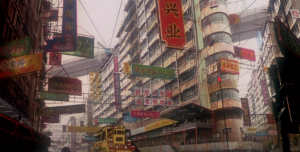[FIELDWORK] GHOST IN THE SHELL
Mamoru Oshii 1995
Streets of Kowloon, Hong Kong
Mamoru Oshii portrays a futuristic city in the 1995 action cyberpunk film – Ghost in the Shell: merging elements of 1990s Hong Kong and Japan. In 2029, technology advanced to a point that allows for cybernetic enhancement and augmentation. The titular character – Major Motoko Kusanagi is a cyborg employed by the security department Section 9. Kusanagi explores her existential reality of being a cyborg and contemplates on how she transcended her own humanity. Section 9 is portrayed amongst multiple high-rise buildings and skyscrapers inspired by Tokyo in the 1990s. Interestingly, although Hong Kong already constructed skyscrapers in the 1990s, the residential districts are more provocative of Kowloon Walled City and Mong Kok’s architecture. The confining 唐樓 Tenement buildings and plethora of commercialized billboards may seem archaic in the world of 2029, but it still creates a perplexing world for Kusanagi to find her humanity.


Mamoru Oshii and art director Hiromasa Ogura depict a perpetual district of Hong Kong’s iconographies throughout the 1960s to 1980s in a montage influenced by Kowloon Walled City. Tenement buildings, billboards, neon lights and bamboo scaffolding on surface level do exemplify the face of Hong Kong, however extra considerations were added to further manipulate Japanese audiences in the authenticity of this montage’s locality: Corrugated rooves, bleached and mouldy walls, and the conglomeration of unique units within a single building are some of the minute details that connects the reality of Hong Kong within Oshii’s film. In contrast the portrayal of a perpetual Kowloon Walled City does not accurately represent modern Hong Kong. Newer symmetrical and more profile buildings inhabit the Kowloon and Mong Kok districts with much of the older iconographies being overshadowed or even disappearing in favor of glass exteriors and metal structural frames in the push for modernity.


Even in the 1990s with the recent completion of the Bank of China and Central Plaza buildings³, the film still characterizes Hong Kong as without any semblance of its modern icons or skylines. The main intent from Oshii was to go from a “deteriorating urban landscape towards high-rise buildings (Section 9)”¹ and to provide Japanese audiences with a non-uniform chaotic cityscape. This called for the preservation of the everlasting domain of “Kowloon Walled City” throughout the montage despite demolition occurring 2 years prior in 1993.² In order to maintain the danger and chaos associated within Kowloon Walled City and fabricate the illusion of Hong Kong lacking development. Furthermore, Kusanagi’s insolation and inability to interact with any residents reinforces how she is just an unrecognized “ghost”, that is loitering through the dangerous city; unable to form connections and is lost amongst the nonenhanced populous. Even lost amongst the city scape as Kusanagi was almost unnoticeable in a far panning shot of presumably a Cha chaan teng, until a close-up revealed her sitting silently. Kusanagi is alienated unintentionally by both the archaic city and the humans, trapped in an insignificant “shell”.
– Lee Ho-june Daniel, 3035823827
Notes:
1 Lum, Patrick. 2018. “Ghost In The Shell’s Urban Dreamscapes: Behind The Moody Art Of The Anime Classic”. The Guardian. https://www.theguardian.com/film/2018/aug/03/ghost-in-the-shells-urban-dreamscapes-behind-the-moody-art-of-the-anime-classic.
2 Wood, Chris. 2018. “Kowloon Walled City: When Hong Kong Called Time On ‘Dirty Old Wart’”. South China Morning Post. https://www.scmp.com/magazines/post-magazine/short-reads/article/2127786/when-death-knell-sounded-kowloon-walled-city?module=perpetual_scroll_0&pgtype=article&campaign=2127786.
3 Wrong, Hong. 2016. “HKFP History: The Evolution Of The Hong Kong Skyline – Hong Kong Free Press HKFP”. Hong Kong Free Press HKFP. https://hongkongfp.com/2016/05/29/hkfp-history-evolution-hong-kong-skyline/.
4 Maurice, Yvon. 2022. Hong Kong Skyline 1990S. Image. Accessed March 20. https://www.flickr.com/photos/19787482@N04/.
Thoughtful reflection on Hong Kong’s built environment, especially the skyline and its iconic fortress-like mid-century buildings and their expansive facades. At the moment, there is little evidence of fieldwork. If you did not conduct a field trip in person, did you do so virtually, i.e. “visit the site” through other people (media reports, personal blogs, videos, etc.) who had done it? Imagine the additional insights to your film analysis had you visited, physically or virtually, one or more of the sites that you discussed – Kowloon Park (its reappearance as a city park), a tenements-lined street in Mongkok (the status of the tenements and signs) or the skyline of Central district from TST (1990s vs 2022).